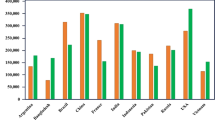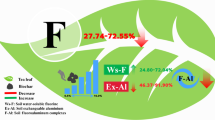Abstract
Background and aims
Tea is a major dietary source of aluminium (Al) to humans. There is a need to understand how environmental factors influence Al accumulation in tea leaves in order to devise strategies to lower Al intake from tea.
Methods
Paired soil and tea shoots were collected from 197 micro-locations across 11 tea plantation estates in Kericho, Kenya. The concentrations of Al and other minerals in tea samples and a range of soil properties were determined. Multiple regression analysis was performed to identify environmental variables that significantly affected tea Al concentration. A comparison was made between washed and unwashed tea samples. Tea samples from a long-term lime and elemental sulphur trial were analysed.
Results
Four environmental variables were identified as having a significant positive effect on tea Al concentration, including soil dust contamination represented by tea Ti concentration, the age of plantation, the number of years after pruning and Al saturation in topsoil, whereas two variables had a significant negative effect, including the altitude of plantation and rainfall prior to tea plucking. The effect of soil dust contamination was further verified by a leaf washing experiment. Soil pH was found to have no significant effect on tea Al concentration in both the field survey and the lime and sulphur experiment.
Conclusions
Liming would not be an effective method to decrease Al concentration in tea. Avoiding soil dust contamination, plucking tea shoots from plantations at higher altitudes or from younger plantations could lower tea Al concentration.




Similar content being viewed by others
References
Berrow ML (1988) Sampling of soils and plants for trace element analysis. Anal Proc 25:116–118
Carr HP, Lombi E, Kupper H, McGrath SP, Wong MH (2003) Accumulation and distribution of aluminium and other elements in tea (Camellia sinensis) leaves. Agronomie 23:705–710
Cary EE, Grunes DL, Bohman VR, Sanchirico CA (1986) Titanium determination for correction of plant sample contamination by soil. Agron J 78:933–936
Cook LL, McGonigle TR, Inouye RS (2009) Titanium as an indicator of residual soil on arid-land plants. J Environ Qual 38:188–199
Dong DM, Xie ZL, Du YG (2001) The bioavailability of Al in soils to tea plants. Appl Geochem 16:1413–1418
Flaten TP (2002) Aluminium in tea - concentrations, speciation and bioavailability. Coord Chem Rev 228:385–395
Fung KF, Wong MH (2004) Application of different forms of calcium to tea soil to prevent aluminium and fluorine accumulation. J Sci Food Agric 84:1469–1477
Fung KF, Carr HP, Poon BHT, Wong MH (2009) A comparison of aluminum levels in tea products from Hong Kong markets and in varieties of tea plants from Hong Kong and India. Chemosphere 75:955–962
Gao HJ, Zhao Q, Zhang XC, Wan XC, Mao JD (2014) Localization of fluoride and aluminum in subcellular fractions of tea leaves and roots. J Agric Food Chem 62:2313–2319
Ghanati F, Morita A, Yokota H (2005) Effects of aluminum on the growth of tea plant and activation of antioxidant system. Plant Soil 276:133–141
Hajiboland R, Rad SB, Barcelo J, Poschenrieder C (2013) Mechanisms of aluminum-induced growth stimulation in tea (Camellia sinensis). J Plant Nutr Soil Sci 176:616–625
Hesse PR (1971) A textbook of soil analysis. John Murray Ltd., London
Joint FAO/WHO Expert Committee On Food Additives (2011) Summary report of the seventy-fourth meeting of JECFA, http://www.fao.org/3/a-at873e.pdf. FAO/WHO, Rome.
Kinraide TB (1997) Reconsidering the rhizotoxicity of hydroxyl, sulphate, and fluoride complexes of aluminium. J Exp Bot 48:1115–1124
Kinraide TB, Ryan PR, Kochian LV (1992) Interactive effects of Al3+, H+, and other cations on root elongation considered in terms of cell-surface electrical potential. Plant Physiol 99:1461–1468
Konishi S, Miyamoto S, Taki T (1985) Stimulatory effects of aluminum on tea plants grown under low and high phosphorus supply. Soil Sci Plant Nutr 31:361–368
Ma JF, Chen ZC, Shen RF (2014) Molecular mechanisms of Al tolerance in gramineous plants. Plant Soil 381:1–12
Matsumoto H, Hirasawa E, Morimura S, Takahashi E (1976) Localization of aluminum in tea leaves. Plant Cell Physiol 17:627–631
Nagata T, Hayatsu M, Kosuge N (1992) Identification of aluminum forms in tea leaves by Al-27 NMR. Phytochemistry 31:1215–1218
Nagata T, Hayatsu M, Kosuge N (1993) Aluminum kinetics in the tea plant using Al-27 and F-19 NMR. Phytochemistry 32:771–775
Page AL (1982) Methods of soil analysis. Part 2. Chemical and microbiological properties. American Society of Agronomy, Soil Science Society of America, Madison
Poschenrieder C, Gunse B, Corrales I, Barcelo J (2008) A glance into aluminum toxicity and resistance in plants. Sci Total Environ 400:356–368
Ruan JY, Wong MH (2001) Accumulation of fluoride and aluminium related to different varieties of tea plant. Environ Geochem Health 23:53–63
Ruan JY, Wong MH (2004) Aluminium absorption by intact roots of the Al-accumulating plant Camellia sinensis L. Agronomie 24:137–142
Ruan JY, Ma LF, Shi YZ, Han WY (2004) The impact of pH and calcium on the uptake of fluoride by tea plants (Camellia sinensis L.). Ann Bot 93:97–105
Ruan J, Ma L, Shi Y (2006) Aluminium in tea plantations: mobility in soils and plants, and the influence of nitrogen fertilization. Environ Geochem Health 28:519–528
Shen RF, Ma JF (2001) Distribution and mobility of aluminium in an Al-accumulating plant, Fagopyrum esculentum Moench. J Exp Bot 52:1683–1687
Shu WS, Zhang ZQ, Lan CY, Wong MH (2003) Fluoride and aluminium concentrations of tea plants and tea products from Sichuan Province, PR China. Chemosphere 52:1475–1482
Tolra R, Vogel-Mikus K, Hajiboland R, Kump P, Pongrac P, Kaulich B, Gianoncelli A, Babin V, Barcelo J, Regvar M, Poschenrieder C (2011) Localization of aluminium in tea (Camellia sinensis) leaves using low energy X-ray fluorescence spectro-microscopy. J Plant Res 124:165–172
Tyler G, Olsson T (2001a) Concentrations of 60 elements in the soil solution as related to the soil acidity. Eur J Soil Sci 52:151–165
Tyler G, Olsson T (2001b) Plant uptake of major and minor mineral elements as influenced by soil acidity and liming. Plant Soil 230:307–321
Wang P, Kinraide TB, Zhou D, Kopittke PM, Peijnenburg WJGM (2011) Plasma membrane surface potential: dual effects upon ion uptake and toxicity. Plant Physiol 155:808–820
Wong MH, Fung KF, Carr HP (2003) Aluminium and fluoride contents of tea, with emphasis on brick tea and their health implications. Toxicol Lett 137:111–120
Yamamoto T, Juneja LR, Kim M (1997) Chemistry and application of green tea. CRC Press Inc., Boca Raton
Zhao F, McGrath SP, Crosland AR (1994) Comparison of three wet digestion methods for the determination of plant sulphur by inductively coupled plasma atomic emission spectroscopy (ICP-AES). Commun Soil Sci Plant Anal 25:407–418
Acknowledgments
This research was funded by Unilever R&D. Research in F. J. Zhao’s group is supported by the Innovative Research Team Development Plan of the Ministry of Education of China (grant IRT1256) and the Priority Academic Program Development of Jiangsu Higher Education Institutions (PAPD).
Author information
Authors and Affiliations
Corresponding author
Additional information
Responsible Editor: Juan Barcelo.
Rights and permissions
About this article
Cite this article
de Silva, J., Tuwei, G. & Zhao, FJ. Environmental factors influencing aluminium accumulation in tea (Camellia sinensis L.). Plant Soil 400, 223–230 (2016). https://doi.org/10.1007/s11104-015-2729-5
Received:
Accepted:
Published:
Issue Date:
DOI: https://doi.org/10.1007/s11104-015-2729-5




